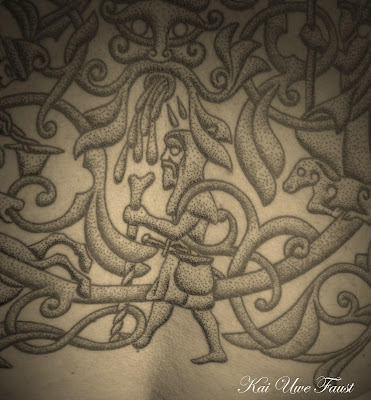Concerning the family history, there are no evidences for the time before 1800, but the linguistic analysis of the last name suggests, that the man's ancestors originated from a hill in the southwestern region of today Germany, an area that was populated by the Alamanns during the Migration period.
Most likely the ancestors of the man where peasants, but that is just a guess, so the first character, the eponymous forebear, living on the hill – symbolized by the man's breast – could be a stock farmer, but also a butcher, a hunter or even a priest, making sacrifice - or just cutting the horns of an aurochs, as well.
The next figure symbolizes an armed man moving to (East-)Prussia, the region allegorised by the (post-medieval) prussian coat-of arms-eagle on the shoulder. To stay within the chosen iconographic context, the character is designed as an alamanic warrior.
In East-Prussia the documented part of the history begins: the oldest assured ancestor was a farmer and presbyter.
One of his sons moved to Westfalen, pictured by the old symbol of that region in the western part of today Germany, the rampant horse, and became a metal worker, represented by the smith-figure. Two generations of metal workers followed him.
The bearer of the actual tattoo eventually choose a different profession and became an archivist. Translating this vocation into the chosen iconographic system, he choose the myth of Mimir and his well. The horn, beeing of importance in different ways to the bearer of the tattoo, completes the circuit.
Thanks for visiting me, wherever i was, for the nice sessions, nice food n drinks ;)


 16.01
16.01
 hadir untuk berbagi
hadir untuk berbagi










 Posted in
Posted in 








0 komentar:
Posting Komentar